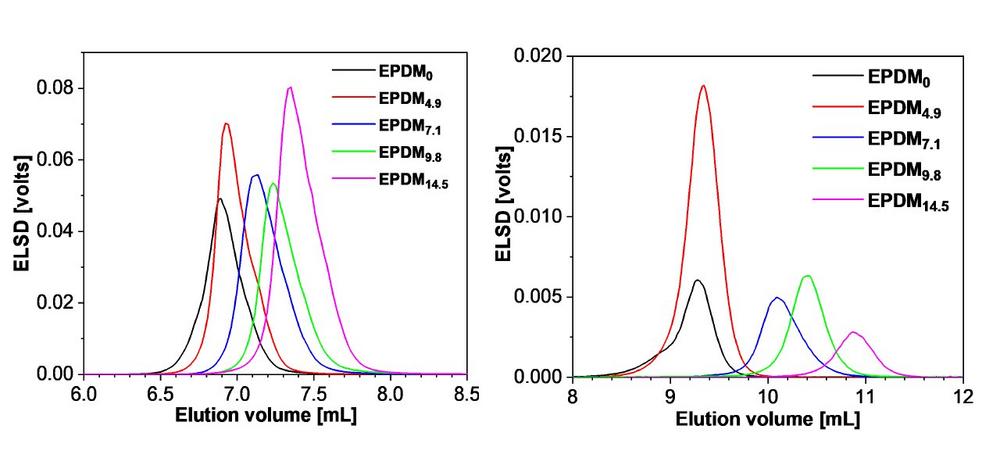Polyolefin elastomers (POE) are highly versatile materials capable of imparting both strength and flexibility to the final product. They offer a balance of properties common for both thermoplastics and rubbers and are used in a myriad of applications such as automotive, vehicle belts and hoses, adhesives, footwear, flooring, tubing, and much more. These resins are typically produced by incorporating olefinic comonomers into the macromolecular backbone to modulate their crystallinity and thus extend the range of product applications. To define the heterogeneity of these elastomeric materials in terms of composition, it is necessary to characterize the chemical composition distribution (CCD). Therefore, whenever new catalysts and processes are used to design complex multimodal elastomers, the CCD becomes the most important structural parameter. Knowledge of the distribution of the pendant double bond in ethylene propylene diene (EPDM) terpolymers, for example, is crucial in understanding and optimizing the vulcanization behavior.
Fraunhofer LBF develops a methodology to identify environmentally friendly solvents for liquid adsorption chromatography
Liquid adsorption chromatography (LAC) is highly relevant from an industrial standpoint, and it is the tool of choice to characterize the CCD. The process of solvent selection in LAC poses a major bottleneck in method development and so far, largely based on trial and error. LAC is based on the reversible adsorption of polymers on a stationary phase. It involves the use of an adsorption-promoting solvent (adsorli) to adsorb the polymer sample onto the stationary phase and a gradient to a desorptionpromoting solvent (desorli) to elute the sample. The amount of desorli needed to elute the macromolecules of a sample is dependent on their specific chemical composition.
The need for high dissolution temperature for polyolefin elastomers has so far limited the available desorlis to chlorinated solvents like 1,2,4-trichlorobenzene (TCB) or 1,2- dichlorobenzene (ODCB). Typical adsorlis currently in use also exhibit high toxicity and are environmentally harmful. Because of environmental concerns, there is a continuous trend toward replacing chlorinated solvents with solvents that have lower toxicity. Focusing on ethylene propylene diene (EPDM) as a representative for polyolefin elastomers we have demonstrated that by combining a chromatographic indicator in terms of structure-retention-relationships with Hansen Solubility Parameters suitable novel non-chlorinated desorlis can be used for LAC to unravel the heterogeneity of EPDM samples.
Free online workshop on June 20, 2023, from 9:30 a.m. to 5:15 p.m.
This and similar topics will be presented in English by speakers from Brüggemann, Continental, Datwyler, Lanxess, Polymertechnik Elbe, Tyromer, UPM, and WDK.
Registration and program:
Fraunhofer Institut LBF
Bartningstr. 47
64289 Darmstadt
Telefon: +49 (6151) 705-287
http://www.fraunhofer.de
Presse und Öffentlichkeitsarbeit
Telefon: +49 (6151) 705-268
Fax: +49 (6151) 705-214
E-Mail: anke.zeidler-finsel@lbf.fraunhofer.de
![]()

